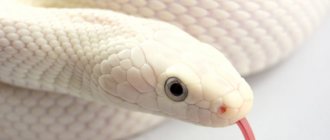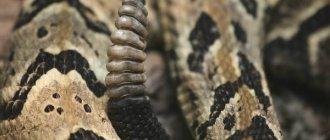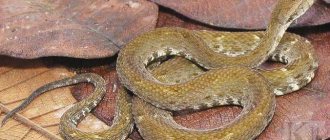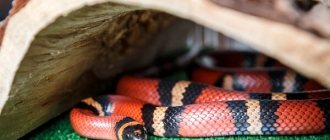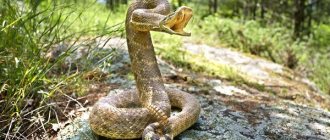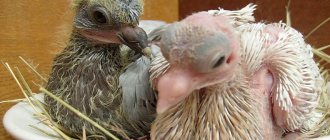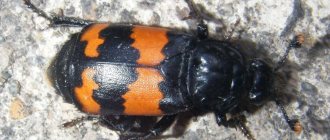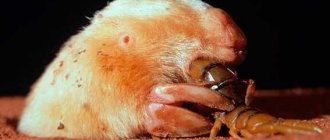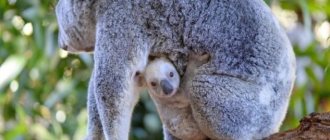Physiology of male and female
Before understanding the birth process of a snake, you should know the physiology of the male and female. And here you can encounter the first problems, since it is quite difficult to visually distinguish females from males.
In the male, the fertilization organs are a pair of hemipenises located in the tail area, in the so-called pockets, on the abdominal part. One of the hemipenises grows to the required size only when a partner is nearby, ready for mating.
Did you know?
There are a number of snakes that are hermaphrodites.
They are characterized by parthenogenesis, a “virgin” method of reproduction in which female cells develop in an adult body without fertilization. Among the hermaphrodites, reptiles of the Blind and Warty families can be distinguished. Females have paired hemicliters, the location of which is almost impossible to determine. The body contains the ovaries, which are connected to the cloaca by the oviducts.
Video: how to distinguish snakes by gender
Based on their external description, you can distinguish a male from a female by certain characteristics:
- the male is larger, longer, looks more powerful and thicker;
- the female is more graceful, but less beautiful, with a faded color.
Structure
It has a distinctively large number of vertebrae, the number of which reaches 450. The sternum and rib cage are absent; when swallowing food, the snake’s ribs move apart.
The bones of the skull are movable relative to each other. The two halves of the lower jaw are elastically connected. The system of articulated bones allows the mouth to open very wide in order to swallow fairly large prey whole. Snakes often swallow their prey, which can be several times the thickness of the snake's body.
The teeth are very thin and sharp. Poisonous individuals have large and backward-curved poisonous fangs on the upper jaw. In such teeth there is a channel through which, when bitten, poison enters the victim’s body. In some poisonous snakes, such teeth reach a length of 5 cm.
Internal organs
They have an elongated shape and are asymmetrical. In most individuals, the right lung is more developed or the left is completely absent. Some snakes have a tracheal lung.
The heart is located in the cardiac sac. There is no diaphragm, which allows the heart to move freely, avoiding possible damage.
The spleen and gallbladder perform the function of filtering blood. There are no lymph nodes.
The esophagus is very powerful, which makes it easy to push food into the stomach and then into the short intestine.
Females have an egg chamber that acts as an incubator. It maintains the level of moisture in the eggs and ensures gas exchange in the embryo.
Feelings
- Smell
To distinguish odors, a forked tongue is used, which transmits odors to the oral cavity for analysis.
The tongue constantly moves, sampling particles of the environment for testing. In this way, the snake can detect prey and determine its location. In water snakes, the tongue picks up odor particles even in water. The main purpose of vision is to distinguish movement. Although some individuals have the ability to obtain a sharp image and see perfectly in the dark.
- Thermal and vibration sensitivity
The organ of heat sensitivity is very developed. Snakes can detect the heat that mammals emit. Some individuals have thermolocators that determine the direction of the heat source.
Earth vibration and sounds are distinguished within a narrow range of frequencies. Parts of the body in contact with the surface have increased sensitivity to vibration. This is another ability that helps when tracking down prey or warning the snake of danger.
Features of conception
As a rule, the sexual instinct in males awakens after the winter awakening. They crawl to the surface, looking for food, as well as a mate for mating.
A little later, the females awaken, however, while still in their burrow, they, by releasing a specific smell - pheromones, make it clear to the male that they are ready to reproduce. Surprisingly, dozens of suitors can flock to such fragrant “appeals”.
The fertilization process is quite interesting. All males, in order to get as close as possible to the female, curl up into balls around her and try, using one of the hemipenises that have increased in size, to get to their “goal”.
As soon as one of the participants succeeds in doing this, and he penetrates the genital organ into the cloaca, the remaining males retreat and crawl away in search of another partner. After the act of mating is completed, the male leaves a so-called plug in the snake’s body, which does not allow the lady to mate with other gentlemen.
It is surprising that a reptile can retain sperm in its body for several years, while fertilizing eggs several times. As a result, only after one single mating can several litters be born.
How do snakes give birth?
Depending on the type of reptile, reproduction, and, as a consequence, the birth of snakes, can occur in three ways: laying eggs, viviparity and ovoviviparity. Let's take a closer look at how small reptiles are born.
Traditional egg laying
About 70% of all snakes carry out classical egg laying during the breeding process. Before females lay eggs, they carefully search for a nest site. When choosing it, reptiles are guided by the following principles: warmth, comfort, silence and safety. As a rule, for forest snakes, various snags and places of rotting organic debris become nests; for desert inhabitants, sand becomes their nest.
When the right moment comes, the male lays eggs, the number of which, depending on the type of reptile, can vary from 10 to 100 units. For example, pythons are capable of leaving up to 100 eggs in one clutch.
On average, their number does not exceed 15 pieces. After laying, a couple of future parents do not move far from their nest, carefully guard it, warm the eggs with their warmth, which contributes to the rapid development of embryos.
Important!
-
bad parents, immediately after the babies hatch, they abandon them and crawl away.
There is simply no need to care for the offspring, because they are initially fully prepared for adulthood. Oviparous reptiles are usually found in warm regions where high air temperatures provide good conditions for proper incubation. Representatives of reptiles that reproduce by laying eggs include most of the asps, pythons and colubrid snakes.
Viviparous method
Some representatives of snakes, for example, the viper, many sea snakes or stripes are viviparous. They give birth to fully formed offspring, ready for independent life.
Did you know?
Snakes are considered record holders for the duration of mating.
Sometimes this process can last from two to ten days. In the process of such “passion,” reptiles are capable of inflicting many wounds and bites on each other. After fertilization of the egg, the embryo begins to develop, which through thin blood vessels receives nutrition from the placenta, and oxygen through special metabolic processes occurring in the female’s body.
It should be noted that the process of embryo growth will be determined by environmental weather conditions. At an air temperature of about +26–32 °C and relative humidity up to 90%, the birth of babies occurs 30–39 days after fertilization.
At lower temperatures - up to 60 days. In rare cases, a female can carry cubs for more than three months.
Ovoviviparity
There are also a number of ovoviviparous reptiles, in which babies hatch from an egg located inside the female. It should be noted that such a birth process is unique in nature and is characteristic only of certain species of snakes - boa constrictors, tiger snakes, and copperheads.
In this case, the embryo grows and develops in the tail part of the female body, in the egg. The cubs receive food from egg whites, and the female supplies them with oxygen.
Important!
Babies born during ovoviviparity are completely independent after birth and ready for adulthood.
When the babies are fully formed, they hatch from an egg in the mother's body. At the same time, the remains of eggs emerge through the female’s birth canal.
Traditional egg laying
Not long ago, scientists estimated that only about 70% of snakes lay eggs. All other species are viviparous or ovoviviparous. Egg laying occurs after copulation, which occurs in the same way in all reptiles. After fertilization, eggs are formed in the female’s body, and after a while she lays them in the nest. Until the offspring appear, the snake sits motionless near them, protecting the cubs from potential enemies. In this state, the female is hungry and very aggressive. Any encounter with a snake hatching babies can end in disaster.
Before giving birth, snakes carefully select a place to form a nest. Piles of rotting organic debris are ideal for these purposes, as they can protect future hatchlings from the elements. The incubation period for eggs varies from one to several months, depending on the variety of cold-blooded fish.
Breeding frequency
Under natural conditions, the breeding process of snakes is seasonal - spring and autumn. In most cases, the mating season of reptiles is preceded by hibernation and the process of rest.
It should be noted that snakes reach sexual maturity at the age of about two years after birth. In one year, females are capable of giving birth to about 100 babies, however, due to the fact that parents do not care for their offspring, most of the offspring die.
Partially refuting the generally accepted opinion that snakes lay eggs for reproduction, it can be noted that 30% of the creeping reptiles are viviparous and ovoviviparous. The process of giving birth to babies in reptiles is quite interesting and unusual. When planning to lay eggs or give birth to babies, the female instinctively looks for the safest and most comfortable place, since immediately after birth the babies “enter” an independent life, without the support of their parents.
In many families of snakes there are species that do not lay eggs, but give birth to live baby snakes. Typically, a live birth is simply the result of eggs being retained in the female's oviducts. Those. eggs develop not in the ground, not in moss, not in a pile of dry leaves, like most snakes, but in the mother’s body. At the same time, a dense network of blood vessels develops in the snake’s oviducts and oxygen from the mother’s blood seeps into the egg, ensuring the baby’s breathing. It gets its nutrition from egg yolk. Zoologists call this phenomenon with the clumsy word “ovoviviparity.” All boas are ovoviviparous (not to be confused with pythons - these are representatives of two different subfamilies!), many vipers, and adders.
However, some snakes have developed true viviparity. In this case, as in mammals, the embryo is connected to the mother by thin blood vessels, and receives not only oxygen, but also nutrition from the mother’s body. Such viviparity is characteristic of the American garter snake, our common viper, and many sea snakes.
Snakes that managed to master viviparity received a lot of advantages. First of all, their eggs are constantly under reliable protection. At the same time, the mother can calmly hunt, and not sit at the nest, tied, like a king cobra, which constantly guards the eggs. In addition, the snake can choose the most suitable places at any given time - well-warmed, which is especially important in the north, or cool, which is very important in tropical deserts. It is very difficult to find a place where favorable conditions are constantly maintained for a long time.
Many readers know that the snake is a viper
belongs to the class of reptiles. But not everyone knows that this family of creeping reptiles has more than 58 species.
The habitats of these creatures are very diverse; for example, they can be found in most of the African continent, in Asia, as well as in most of European territory.
Vipers thrive both in the arid steppes and in the humid climate of the forests of the equator. They can settle on rocky mountain slopes and inhabit northern forests.
Basically, vipers prefer a terrestrial lifestyle, but among their relatives there are often individuals that lead an underground lifestyle hidden from prying eyes. A striking representative of this species can be called the earthen viper
from the genus Atractaspis.
Ground viper
The main factors for the life of snakes of this family are the availability of food and a sufficient amount of light. They are not so demanding about everything else. Class of vipers,
as previously noted, very diverse, but we will talk about four representatives in more detail. So, get acquainted.
The common viper lives throughout the European part of the globe, in parts of Asia, even in the north, right up to the Arctic Circle. She leads a sedentary lifestyle - she does not like frequent changes of habitat.
The snake overwinters in crevices of the ground, in rodent burrows and other secluded places. It usually leaves its winter habitat in mid-spring, but this depends on the geographic location.
The photo shows a common viper
Geography of the steppe viper's
very extensive.
It can be found in the steppes of the European zone, especially in the western part. She settled in Eastern Kazakhstan, the steppe regions of the Caucasus and the coast. about vipers
; for example, they are capable of performing forced marches to altitudes of up to 3000 m above sea level.
Snakes often choose a certain territory for their habitat, where there are no other representatives of this class besides them. In winter, creeping creatures take refuge underground, and they bury themselves to a decent depth (1.0 meter or more).
Pictured is a steppe viper
But the fact is that even with a slight minus, the snake can die, so these cautious creatures play it safe and go to spend the winter at a depth that can retain heat. Vipers often hibernate in large groups, but can also hibernate alone.
Having awakened from a long winter sleep, with the onset of spring, vipers crawl out of their shelters and find rocky surfaces, where they enjoy sunbathing.
In our country, the common and steppe viper
can be found everywhere and meeting it does not bode well for a person.
After all, the venom of large individuals is fatal to humans, not to mention small animals and birds, for which a small amount of the deadly substance is enough to die when bitten. A full-fledged viper bite
causes the death of the victim within a few minutes.
King cobra nest
There are not very many snakes that build their own nests. One of them is the hamadryad, or king cobra. It lives in tropical areas of Southeast and South Asia where there is heavy rainfall. To prevent the nest from flooding, it is built on a small ledge or hill.
Eggs are laid only a month after mating.
The character and lifestyle of the viper
Vipers cannot be called record holders in running, because they are too slow. They are able to spend the entire day lying down without unnecessary movements. But with the onset of dusk, snakes become more active and begin their favorite pastime - hunting.
It should be noted that large individuals can lie motionless for a long time, waiting for the prey to fall into the affected area, and then the viper will not miss the chance to feast on what itself came to it as lunch.
The main distinguishing feature of vipers is that they are fluent in the art of swimming; swimming across a wide river or a fairly large body of water is a breeze for them.
This is probably why vipers can most often be found on the banks of reservoirs, but they also do not disdain swamps, and here they are simply teeming. People often use the phrase “a swamp infested with vipers,” and this is not without common sense.
Vipers love to settle in wetlands
Everyone knows that snakes lack limbs, but this does not bother them. After all, they can move freely with the help of their natural plasticity and soft spine. Gracefully wriggling among the stones, the creeping creatures are capable of developing quite a decent speed.
But God did not endow these creatures with good hearing and visual acuity. Snakes completely lack an auditory opening, and their eye sockets are covered with a dense transparent veil. The eyelids of reptiles are fused, and therefore they cannot blink.
It is reliably known that the black viper
poisonous
The only representative of this class does not pose a danger to humans. Signs of a viper
: snakes have two large teeth in which venom accumulates.
Pictured is a black viper
The toxic substance is produced by paired glands located on both sides of the eyes, and they connect to the teeth through ducts. Interestingly, all species have an interesting dental structure. The poisonous fang is located on a bone, which is very mobile.
Therefore, when the snake’s mouth is closed, the tooth takes a horizontal position, but as soon as the creature opens its mouth slightly, the poisonous fang stands up and takes a vertical position.
Common viper
. This particular type of snake is considered the most common. This reptile reaches half a meter, but there are also larger specimens, whose length from head to tip of tail is 80 centimeters.
A distinctive feature of the viper is its zigzag pattern.
The structure of her head is triangular, and this part stands out noticeably against her thick body. Nature has endowed vipers with a wide variety of shades - from inconspicuous gray to bright red-brown. There are also black, olive, silver, and bluish vipers.
A characteristic feature of the color is a dark zigzag running along the entire ridge. It is not so often that you can find a viper with dark stripes located across it. On the head of reptiles there is an identifying characteristic mark in the form of the letter V or X.
A clear black stripe runs through the center of the eyes along the entire area of the head. Interesting fact: snake catchers counted the number of scales on the body and found that there were 21 scales around the body in the middle part (rarely 19 or 23).
In principle, the snake will not bite innocent people. Only if an unwary traveler steps on her, then she will give a worthy rebuff. Such snakes are called peace-loving. She will prefer to quickly move away from the place where she can be noticed and hide.
Steppe viper
. This species of reptile is much smaller in size than the previous species and an adult, as usual, can rarely reach half a meter. Unlike its relative the common viper, the steppe viper has a pointed, slightly raised snout.
Vipers have poor eyesight, which is compensated by their quick reaction
The nostrils cut through the lower part of the nasal septum. There is a black curving stripe along the entire length of the body and along the ridge. Dark spots appear clearly on the sides. If you turn the reptile onto its back, you can see that its belly is gray with numerous specks of a light shade.
If you compare the bite of the steppe
and
the venom of the common viper
, then the first option will be less dangerous for humans.
Gaboon viper
. A striking representative of African venomous snakes. This is a truly respectable individual.
The Gabon viper is found in Africa
Its body is thick - 2.0 meters or more, and the weight of fattened individuals reaches 8-10 kg. The snake is quite remarkable for its bright variegated coloring, which resembles a hand-painted carpet.
The drawings are filled with various geometric shapes of various bright saturated colors - pink, cherry, lemon, milky, blue-black. This snake is recognized as one of the deadliest, but due to the fact that it is very phlegmatic, many believe that it is not as dangerous as everyone thinks about it.
You can pick her up by the tip of her tail without any danger to her health, put her back, and she won’t even want to make a menacing appearance. But teasing a snake is extremely undesirable, because it remains angry for a long time and it is unlikely that you will be able to “conspire” with it.
Among other things, the Gaboon viper has the longest teeth full of poison. Looking at the photo of vipers
You can see the distinctive features of reptiles.
Snakes are not poisonous representatives of vipers. Identify a snake
Viper
identified
by bright orange spots located on the side of the head. In addition, they have round eye pupils, and in the previously described species, and in all others, the pupil is narrowed and located vertically.
Also, this type of snake does not have the characteristic zigzag on its back. Although the coloring of the water snake is very similar to the coloring of the viper, because many people confuse the checkerboard arrangement of spots with the characteristic meander along the ridge.
The photo shows a water snake, which, due to its similar color, is often confused with poisonous vipers
But up close you can see that the spots are interrupted and do not form a continuous zigzag. From the head to the tip of the tail it narrows evenly and a triangular head is unusual for him.
Viper food
By nature, all types of snakes are predators. They are capable of swallowing prey whole, and not only small rodents and birds, but also fairly large animals, such as others. Sometimes the prey is much thicker than the reptile’s body, which does not prevent the snake from swallowing it whole.
The viper is able to perform such actions thanks to the special joints of its jaws. The structure of the lower jaw allows it to stretch forward and then return to its original position.
In addition, the halves of the jaws are connected at the chin and, if necessary, can easily move apart.
The composition of the viper's diet depends on its habitat. Usually for lunch they prefer mice and. But chicks are their favorite food. Small animals, amphibians and lizards are added to this list. It is very interesting to watch the viper when it hunts.
The main prey of steppe vipers are rodents and insects. Being excellent at climbing trees, it is not difficult for them to check the nests of birds, as well as birdhouses, in order to find their favorite delicacy there - chicks. Bird eggs also bring them pleasure. However, this snake loves to pamper itself with a delicacy in the form of small ungulates.
The Gaboon viper is a hunter by nature. It will take a place in an ambush, wait until dusk, and when the warm-blooded animal approaches the required distance, it will pounce and swallow it whole. She loves to eat hares and other inhabitants of her range. She will not disdain to taste the dwarf, which has strayed from the herd.
Diet, prey
Rattlers, like typical ambush predators, take a position and wait for the prey to approach within throwing distance. A signal of an upcoming attack is the S-shaped bend of the neck, in which the head of the rattlesnake looks towards the enemy. The length of the throw is equal to 1/3 of the length of the snake's body.
Like other vipers, pit vipers kill prey with venom rather than using chokeholds. Rattlesnakes feed mainly on small warm-blooded animals, but not only on them. The diet (depending on the area) contains:
- rodents, including mice, rats and rabbits;
- birds;
- fish;
- frogs;
- lizards;
- small snakes;
- insects, including cicadas and caterpillars.
Adolescent snakes often use their brightly colored tail tip to lure lizards and frogs.
During the day, rattlesnakes find prey using their normal senses of vision, but an object frozen without movement may not be noticed. At night, temperature-responsive pits come to their aid, distinguishing fractions of degrees. Even in pitch darkness, the snake sees the thermal contour of the prey created by infrared radiation.
Reproduction and lifespan
The mating season for snakes occurs in the spring - usually in May. The pregnancy of a viper, like many other reptiles of the reptile class, depends on the weather and lasts from three months to six months. What is most surprising is that sometimes a pregnant snake can even overwinter.
They usually give birth to 10-20 young of their own kind. When born, they immediately inherit poisonousness from their parents. A few hours after birth, the young individuals molt. You can observe an interesting moment during childbirth.
The photo shows the birth of a viviparous snake
The female wraps herself around the tree, and the born cubs fall straight to the ground. The cubs live on the forest floor or in burrows and feed on insects. A snake can begin to reproduce at a fairly advanced age for reptiles - about 5 years. Males become sexually mature at 4 years of age.
The average lifespan of vipers in nature is 10 years. Steppe vipers begin to reproduce at the age of 3. Life expectancy is shorter than that of ordinary vipers, only 7-8 years. The Gaboon viper, like all described species, is viviparous.
Males, like true gentlemen, never bite each other during courtship. The gestation period lasts about 12 months. She is capable of producing from 10 to 40 cubs.
Many people are accustomed to believing that all snakes lay eggs, and happy offspring hatch from them.
In fact, there are ovoviviparous snakes that do not lay eggs , but carry them inside themselves.
This fact (captured on video) shocked some and provoked an existential crisis for others. Reptile Collective breeds captive snakes for sale, specializing in ball pythons, hog-nosed snakes and Kenyan sand boas. It sounds harmless enough, especially if you're cool with snakes. But recently their humble company shocked Facebook users and almost caused an existential crisis for hundreds of thousands of people.
On their Facebook page, employees published a short video showing the birth of a sand boa. This reptile is ovoviviparous and you will not see any eggs. They are inside the female, and the cubs leave the egg shell while still in the mother’s body, and it looks as if the snake directly gives birth to snakes.
Some readers may find the video disturbing. If you're not sure, just trust us: there's a snake giving birth to six snakes (they're different colors, and that's okay).
In comparison, Facebook users feel less good. The video with the viviparous snake went viral and collected more than 9 million views in three days. This popularity is primarily due to the fact that many did not know that some snakes give birth in this way, and do not lay eggs.
“I thought snakes were laying eggs. Forgive me for my ignorance."
"Never mind. We’re all like that here.”
“I thought so too. And I’m like, damn, what’s going on?”
"Baby, you're not the only one."
“I'm completely confused. I was taught that snakes lay eggs.”
"What the heck. I thought snakes laid eggs."
Some users blamed school education for everything.
“So boas are now mammals? All my biology classes failed me.”
“I’ll go find all my elementary school teachers and fire them myself. Snakes lay eggs, but it’s 2022 and things are probably different.”
In fact, only about 70 percent of all snakes lay eggs, with the rest being viviparous or ovoviviparous. Snakes with eggs most often live in warm regions, while viviparous snakes live in cold regions (where the eggs would freeze).
The non-venomous sand boa is a pseudopod snake (they have small rudimentary appendages instead of hind limbs). Females grow up to 80 centimeters in length, males up to 60 centimeters. A distinctive feature of the species is the location of the eyes - on the top of the head and directed upwards.
Not only can snakes give birth to live snakes, but they can also play hide and seek with humans. Zoologists who are professional snake catchers in Queensland photograph hidden snakes during their field trips and then . It's difficult to do this the first time. Sometimes snakes don't hide, but... Sometimes a snake. But you can still make friends with them. Like this girl who...
The animal world is diverse and ready to constantly surprise us. Few people wonder whether there are viviparous snakes, because we are all accustomed to thinking that snakes lay eggs. But, as it turns out, nature springs a surprise here too - some species give birth to live babies. According to National Geographic, only 70% of species lay eggs. The remaining 30% are viviparous or ovoviviparous. In this article we will talk about the types of snakes that give birth to live babies.
Caring for offspring
The female, and sometimes the male, take great care of their clutch. The nest is often built in a heap of garbage, old leaves, and rotten grass. This helps provide the warmth necessary for the development of babies: the process of decay of organic matter warms the eggs. If this is not enough, the mother can, by contracting her muscles, increase the temperature around the eggs by several degrees for a long time.
Even when going hunting, snakes do not leave the nest for long and do not move far from it in order to repel the attack of small predators or birds in time, because eggs are a very tasty prey.
Snakes are extremely selfless mothers; while they protect the eggs, they fight tooth and nail if someone encroaches on the nest. Oviparous snakes carefully “listen” to the processes occurring inside the shell in order to help the weak snakes destroy the barrier at the right moment. The first cracks and holes do not go unnoticed by the mother. But as soon as the head, and then the body, emerge from the shell, the snake stops caring for the tiny newborn.
The same thing happens with viviparity, ovoviviparity - as soon as the babies are born, interest in the offspring disappears. Small snakes are fully formed and their instincts are so well developed that they can immediately get their food. Larvae, insects, small birds - the snake eats everything it can swallow.
Perfect methods of survival and preservation of the population, the ability to fall into suspended animation if conditions do not allow adequate nutrition, or it became too cold, or heat descended to the surface - all this helped snakes live and develop for millions of years.
This is interesting! Becoming sexually mature, often at 2 years, females can give birth to up to 100 babies annually.
And they did not completely fill the earth only because even such formidable predators have enemies . Most of the offspring die in the first 1-2 years in the paws of birds or the teeth of large cats and rodents. The lifespan of snakes in captivity reaches up to 40 years, but in nature they rarely live to 10-13.
Main types
Those who know a little about snakes doubt whether there are viviparous species. After all, it is generally accepted that these reptiles lay eggs. In fact, live birth is a consequence of the retention of eggs in the mother's oviducts.
In other words, eggs do not develop outside, in the ground or in moss, but in the body of a reptile. Moreover, a dense network of blood vessels is formed in the female’s oviducts, which helps oxygen enter the egg, which allows the fetus to breathe. Both poisonous species and completely harmless ones can be viviparous.
And here are some snakes that do not lay eggs:
- copperhead
It is considered conditionally poisonous, since the poison affects only small, no more than 70 cm, vertebrates. Lives in almost all regions. A rather shy animal that avoids humans. The main food of the copperhead is lizards, small reptiles, and insects. It does not pose a threat to humans; - Gaboon viper (Bitis gabonica).
A poisonous species that lives in the African plains. It is considered the largest and thickest species of viper. The average body length is 2 m, body girth is 0.5 m. Like other vipers, the Gabon viper has a triangle-shaped head, and small horns are visible between the nostrils. The character is quite calm, it rarely attacks people. Reproduces every 2–3 years. One litter produces 24–60 baby snakes; - garter snakes, or garden snakes.
These are small animals measuring 50–80 cm. They lead a mainly diurnal lifestyle. The head is practically no different from the body. Garter snakes are found in North and Central America. They feed on frogs, larvae of tailless amphibians, toads, newts, salamanders, small rodents, lizards, snails, spiders, worms and insects. May be kept in captivity; - common viper (as well as steppe, black).
This poisonous predator can be found everywhere: in the garden, in the meadow, on the banks of reservoirs.Important!
The viper is often confused with an ordinary snake.
The body length of the viper reaches 60–80 cm, and skin tones vary from brown-brown to green, pink and yellow. A distinctive feature is a zigzag stripe on the back. The head is flat, rounded, decorated with an X-shaped pattern.
The above names of viviparous snakes are not a complete list, but only the most popular representatives of viviparous snakes. These also include marine species that simply have nowhere to lay their eggs and take care of them in the future.
Viviparous reproduction of snakes
Snakes are loners, but their mating season fascinates with its grace, so the process of mating, bearing and giving birth to babies deserves special attention.
Mating process
Sexual maturity of most snakes occurs at two years and depends on the length of the reptile. As soon as the season approaches (and for snakes it begins almost after waking up from hibernation), males begin to actively look for a partner.
Did you know?
Courtship is not an unnecessary procedure.
It allows you to recognize a partner of your own species. Some snakes' movements may resemble dancing, while others simply caress the female's back with their chin. At the same time, they use a specific analyzer, “probing” the air with their tongue and thus obtaining microparticles of the substance left by the female. These components will tell whether the male has a chance of copulation.
At the end of courtship, the partners intertwine their tails, and the males insert the hemipenis into the female's cloaca. The copulatory organ in males is double and consists of hemipenises that protrude from the cloaca.
Since several males can hover around the female during copulation, the reptiles form balls. But only one male can fertilize a female, who, in addition to sperm, secretes a special substance that prevents fertilization by other males.
The female is capable of storing live sperm. This feature allows broods to be produced several times after a single copulation.
Bearing offspring
The embryos of viviparous snakes feed in the mother's body. Moreover, their main food is the yolk, which is formed in the oviducts. The fetus receives additional nutrition and oxygen thanks to the metabolic processes of the female’s body. The embryo develops depending on temperature conditions. At an air temperature of +26...+32 °C and humidity up to 90%, females bear babies for 35–39 days.
Important!
If the weather is cold, then pregnancy can drag on for 3 months or more.
By the way, viviparity is a positive thing, but for marine species it is a necessity. Indeed, in this case, the babies are always near the mother, and she can not become attached to one place and hunt anywhere and at any time.
Birth
The babies appear already fully viable, in a transparent leathery shell. After release, the shell immediately ruptures. Females are indifferent to the babies born and do not take part in their lives. However, baby snakes do not need maternal care; they can hunt from birth.
Breeding frequency
The frequency of intercourse depends on the species and habitat of the reptile. Some can reproduce once every few years, and some - 1-2 times a year. Basically, snakes reproduce annually.
Did you know?
Snakes do not drink milk - their bodies simply cannot digest lactose.
As you can see, the world of snakes is amazing and exciting. And the very process of the birth of little snakes deserves special attention. Having learned more about them, many become fascinated with these reptiles for life.
Dream Interpretation - Bite
A dream in which you bit your man means true love; if he did the same, there is complete reciprocity between you, based on common spiritual interests. If you are bitten by a rabid animal, this means illness and failure; if it is a lion, you will experience pressure from competitors. A dream in which you received a fatal bite from a poisonous snake and are shuddering in death convulsions is a sign of impatience in anticipation of upcoming intimacy with a man. If you are bitten by a small but feisty dog in a dream, in reality you will suffer minor losses, and if a huge dog bites you, your financial situation will sound an alarm. Being bitten by fleas, bedbugs or ticks will leave an unpleasant aftertaste on your soul from meeting a vile type who once dishonored you.
